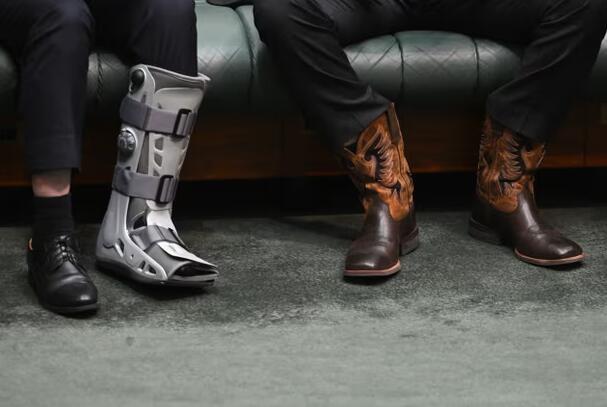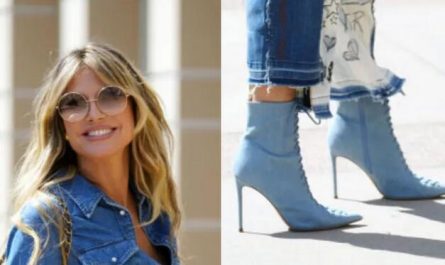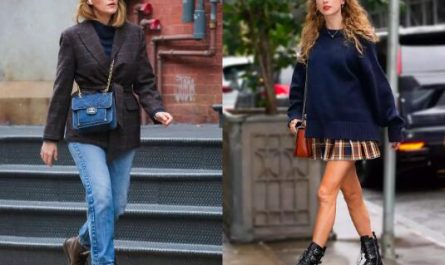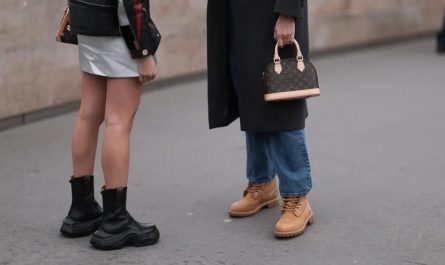Earlier today, as I was reverse Google image searching a picture of Barnaby Joyce’s feet, I wondered if I was perhaps taking this too seriously.
The National party MP has been attending parliament without his habitual RM Williams boots in protest against the owner of the classic Australian fashion brand, Andrew “Twiggy” Forrest, whose company Squadron Energy is building wind and solar developments across New South Wales and Queensland, including in Joyce’s electorate of New England.
Joyce told 2GB radio on Wednesday that the idea came to him at Beef Week in Rockhampton. He said he had no issue with Forrest personally, but objected to the “swindle-factory so-called windfarms all over our area”.
“I thought I’ll make a statement so people will say, ‘why are you doing that?’” he said.
Well, mission accomplished. But I remain confused. Because in the place of the RMs at question time earlier this month was a pair of Ariat cowboy boots. Specifically, my image searching revealed, the Cowpuncher VentTEK in the dark brown/golden mustard colourway.
According to the product description, the boots are designed to provide “a soft landing when you jump off the feed truck or off your horse”, while the vents in the scrolling “keeps you cool in the heat or in branding season”
This is fine. I’ve got nothing against a good pair of Ariats, though as a horse rider in the English disciplines my Ariats are a pair of half chaps. (That also precisely ages me, for anyone who follows equestrian fashion trends.)
They’re also more comfortable than RM Williams – Joyce said as much in that interview. They’re a work boot, and he is at work, and as a person who wears farm boots literally everywhere I cannot begrudge him on an aesthetic level.
But what perplexes me is why he chose Ariats. Ariat is a quintessentially American brand – it’s named for the racehorse Secretariat. This would be like an American politician trying to appeal to their patriotic base by wearing boots called Phar Lap. The main argument for Australian politicians wearing RM Williams is that they are an iconic Australian brand – although before Forrest bought it the brand was owned by LVMH, more commonly known as Louis Vuitton.
The Australiana is, in the theatre of parliament, the whole point. We don’t give visiting dignitaries an Akubra and a Driza-Bone because they’re appropriate bureaucratic attire. If this can be cancelled out by a mining magnate following the economic winds and investing in renewable energy, a decision that whatever other motives you might ascribe is clearly that of a billionaire making a business decision, then we may as well have been wearing lace-ups this whole time
Ariat is also not necessarily a choice that signals disdain for renewable energy: the Fisher family, founders of the Gap, bought the equestrian apparel company in 2012. The Gap has an emissions reduction goal of 90% by 2030 and its chairman, Robert Fisher, is an environmentalist who sat for 20 years on the board of the National Resources Defense Council, an organisation which supports, among other things, federal tax incentives to boost the renewable economy and responsible construction of offshore windfarms.

It is particularly perplexing because another boot option is right there: Gina Rinehart, who very loudly does not support renewable energy, bought Rossi Boots through her company S Kidman & Co in December. As the Australian Financial Review pointed out, this set the stage for the “battle of the billionaire boots”. You can now signal your allegiance simply by the stitching on your boot tug.
Blundstone, which is still Australian-owned although they are no longer manufactured in Tasmania, is another option. Or Baxters, also Australian-owned and manufactured overseas.
As an extremely dorky horse girl who was – and remains – incapable of tying shoelaces so they won’t become unravelled within 20 minutes, I have owned all of these boots.
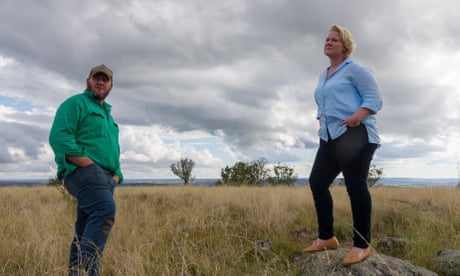
I have RMs for the office, Blundstones for walking through mud on the farm, and Dublin short boots (or Jodhpur or paddock boots or whatever you want to call them except for Chelsea boot) for riding. The key consideration, with the exception of the RMs, which my mum gave me for my 30th birthday when she realised I was turning up to the office in a pair of extremely beat-up 15-year-old Baxters, is cost of replacement. I wear my boots until my socks soak through and the average lifespan is about two years.
Joyce’s Ariat roper boots ($450) or the standard shoe of Australian politics or consulting, the RM Craftsman ($649), are too expensive for such use. The latter are sale day boots, fancy boots – that’s the reason the National party started wearing them in the first place. You would never wear your work boots to a livestock sale or a dinner or a political meeting. The well-kept chestnut leather of a pair of RMs that spends the rest of the month sitting buffed clean in the wardrobe is a sign of respect.
Despite the price tag, roper boots don’t really have that cachet. It’s one thing to pretend to be a working farmer, it’s another to cosplay as Clinton Anderson.
But perhaps that’s the point. The Australian right is increasingly importing tactics from rightwing groups in the US, it may as well copy the footwear. As Joyce took to the stage at an anti-renewables rally in Canberra earlier this year, a man shouted into the microphone: “We need someone like Donald Trump to save us.”
